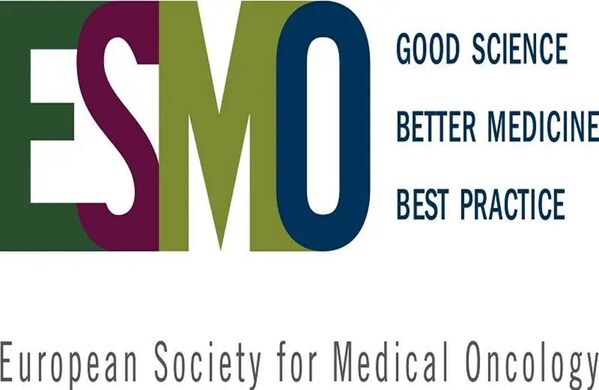CHENGDU, China, Sept. 9, 2024 /PRNewswire/ -- The European Society for Medical Oncology (ESMO) Congress 2024 will be held in Barcelona, Spain from September 13 to 17, 2024. Sichuan Kelun-Biotech Biopharmaceutical Co., Ltd("Kelun-Biotech", 6990.HK)will present the following results of its anti-TROP2 ADC sacituzumab tirumotecan (sac-TMT, formerly SKB264/MK-2870).
1.Efficacy and safety of sac-TMT plus pembrolizumab (KEYTRUDA®) in patients with recurrent or metastatic cervical cancer (CC), to be presented in a mini oral session on September 15, 2024, 14:55-15:00, local time (presentation number: 716MO);
2.Safety and efficacy of sac-TMT monotherapy in patients with previously treated advanced endometrial carcinoma (EC) and ovarian cancer (OC) from a phase 2 study, to be presented in a mini oral session on September 15, 2024, 14:50-14:55, local time (presentation number: 715MO); and
3.Exploratory analysis of patients with or without prior PD-(L)1 inhibitors in phase 3 OptiTROP-Breast01 study of sac-TMT versus chemotherapy for previously treated advanced triple-negative breast cancer (TNBC), to be presented as a poster on September 16, 2024, local time (presentation number: 386P).
The abstracts for the above studies were published on the official website of the ESMO Congress on September 9, 2024, local time. The study results are summarized as follows:
CC
Patients with recurrent or metastatic (R/M) CC who had progressed on or after platinum-doublet chemotherapy and received no more than 2 systemic therapies (PD-(L)1 inhibitor allowed) for R/M disease were enrolled in this study. Sac-TMT at 3 or 5 mg/kg Q2W plus pembrolizumab at 400 mg Q6W was assessed in safety run-in period and the doses deemed well tolerated were explored in expansion period.
As of data cutoff of March 25, 2024, 38 patients were treated and followed up for at least 17 weeks or 2 tumor assessments (3 received sac-TMT at 3 mg/kg, 35 received sac-TMT at 5 mg/kg). The median follow-up was 6.2 months. The median age of patients was 52 years. 76.3% had squamous histology, 47.4% had received two prior lines of therapy, 52.6% had received bevacizumab, and 42.1% had received anti-PD-1-based therapy. The ORR was 57.9% (22/38, 19 (50%) confirmed), with 3 complete responses. Median duration of response (DoR) was not reached and the 6-month DoR rate was 82.1%. Responses were also observed in patients who were pre-treated with anti-PD-1 based therapy (ORR 68.8%, 11/16). Median PFS was not reached and the 6-month PFS rate was 65.7%.
Grade ≥3 treatment-related adverse events (TRAEs) occurred in 47.4% of patients. The most common Grade ≥3 TRAEs were neutrophil count decreased (23.7%), anemia (21.1%) and white blood cell count decreased (15.8%). TRAEs led to dose reduction of sac-TMT in 44.7% of patients and discontinuation of sac-TMT in 1 pt (2.6%). No TRAEs led to discontinuation of both drugs.
A Phase 3 global study sponsored by MSD evaluating sac-TMT monotherapy versus treatment of physician's choice (TPC) as second-line treatment for patients with recurrent or metastatic CC is ongoing (NCT06459180).
EC and OC
Two cohorts of patients with advanced EC and OC, respectively, who had previously been treated with platinum-based chemo were given sac-TMT at 5 mg/kg Q2W until disease progression, unacceptable toxicity or withdrawal of consent. The TROP2 expression was scored using the semi-quantitative H-score method, and cut-off point was set to 200.
As of data cutoff of March 5, 2024, 44 patients were enrolled to the EC cohort and median follow-up time was 7.2 months. 52.3% of patients had received ≥ 2 prior lines of therapy. The objective response rate (ORR) was 34.1% (15/44, 12 confirmed) and the disease control rate (DCR) was 75%. Median progression-free survival (PFS) was 5.7 months (95% CI: 3.7, 9.4) with 6-month PFS rate of 47.5%. For patients with TROP2 IHC H-score > 200 (n=12), the ORR was 41.7% (5/12, 3 confirmed) and for patients with an H-score ≤ 200 (n=28), the ORR was 35.7% (10/28, 9 confirmed). 40 patients were enrolled to the OC cohort and median follow-up time was 28.2 months. All patients had received ≥ 2 prior lines of therapy (with 80% of patients receiving ≥3 prior lines) and 87.5% of patients were platinum-resistant. The ORR was 40% (16/40, 14 confirmed) and DCR was 75%. Median PFS was 6.0 months (95% CI: 3.9, 7.3) and median overall survival (OS) was 16.5 months (95% CI: 10.7, NE). In patients with TROP2 IHC H-score > 200 (n=13), the ORR was 61.5% (8/13, 7 confirmed) and in patients with an H-score ≤ 200 (n=22), the ORR was 27.3% (6/22, 6 confirmed). In the patients who are platinum-resistant (n=35), median PFS was 6.0 months (95% CI: 5.3, 7.3) and median OS was 16.1 months (95% CI: 10.5, NE).
Grade ≥3 treatment-related adverse events (TRAEs) occurred in 72.7% and 67.5% of patients with EC and OC, respectively. The most common Grade ≥3 TRAEs (≥15%) (EC and OC) were neutrophil count decreased (43.2% and 30.0%), white blood cell count decreased (40.9% and 22.5%), anemia (29.5% and 35.0%) and stomatitis (13.6% and 15.0%). TRAEs led to discontinuation in 1(2.3%) and 5(12.5%) patients with EC and OC, respectively.
A Phase 3 global study sponsored by MSD evaluating sac-TMT as a monotherapy for the treatment of EC who have received prior platinum-based chemotherapy and immunotherapy is ongoing (NCT06132958).
TNBC
Patients with locally recurrent or metastatic TNBC who had received ≥2 prior therapies, with at least one given in the metastatic setting, were randomized to receive either sac-TMT or treatment of physician's choice (TPC: eribulin, capecitabine, gemcitabine, or vinorelbine). The primary endpoint was PFS by blinded independent central review (BICR).
As of Nov 30, 2023, 24.6% (32/130) of patients treated with sac-TMT had received prior PD-(L)1 inhibitors and 27.1% (36/133) treated with TPC had received prior PD-(L)1 inhibitors. Clinical benefit was observed with sac-TMT versus TPC in this subgroup. The median PFS by BICR was 5.6 months versus 2.7 months (HR 0.31; 95% CI 0.17-0.54), and ORR by BICR was 56.3% for those treated with sac-TMT versus 5.6% for those treated with TPC. For those patients who didn't receive prior PD-(L)1 inhibitors, similar improvements in efficacy outcomes were observed with sac-TMT versus TPC. The median PFS was 7.2 versus 2.3 months (HR 0.34; 95% CI 0.23-0.48), and ORR was 41.8% versus 14.4%.
Safety data in the sac-TMT arm were similar between patients with prior or without prior PD-(L)1 inhibitor treatment.
The results from the Phase 3 OptiTROP-Breast01 study of sac-TMT in patients with previously treated locally recurrent or metastatic TNBC was presented on June 2, 2024 at the 2024 ASCO Annual Meeting, details of which may be found in the Company's 2024 interim result announcement and announcement dated May 24, 2024.
A Phase 3 global study sponsored by MSD evaluating sac-TMT plus pembrolizumab versus TPC in patients with TNBC who received neoadjuvant therapy and did not achieve a pathological complete response (pCR) (NCT06393374) and a Phase 3 study sponsored by the Company of sac-TMT in China for 1L treatment for patients with unresectable advanced, recurrent or metastatic TNBC whose tumors are PD-L1 negative or in patients whose tumors are PD-L1 positive and have relapsed after prior anti-PD-(L)1 inhibitor in early setting (NCT06279364) are both ongoing.
In May 2022, the Company licensed the exclusive rights to MSD (the tradename of Merck & Co., Inc, Rahway, NJ, USA) to develop, use, manufacture and commercialize sac-TMT in all territories outside of Greater China (which includes Mainland China, Hong Kong, Macao, and Taiwan). KEYTRUDA® is a registered trademark of Merck Sharp & Dohme LLC, a subsidiary of Merck & Co., Inc., Rahway, NJ, USA.
The incidence rate of cervical cancer ranks first among the three major malignant tumors in gynecology, and is the fourth leading cause of cancer deaths among women. According to the "China Malignant Tumor Discipline Development Report (2023)", the incidence of gynecological tumors in China continues to show an increasing trend, in which the number of annual incidence cases of cervical cancer is 119,300, and the number of annual death cases is 37,200 [1]. Endometrial cancer (EC), as the second common gynecological malignant tumor after cervical cancer (CC), accounts for 20% to 30% of gynecological malignant tumors, with 77,700 new cases and 13,500 deaths in China in 2022 [2]; surgery is the main treatment for endometrial cancer, and except for the patients who can not tolerate surgery or who can not be operated in advanced stages, they should be operated with the supplement of Radiation therapy, chemotherapy, hormone and immune-targeted therapy and other comprehensive treatments. In addition, as the third common gynecological malignant tumor, the incidence rate of ovarian cancer (OC) is also high, and the number of new patients with OC in China in 2022 was 61,100 [2], with the incidence rate ranking the third of female reproductive system tumors [3].
In addition to the above three common gynecological malignant tumors, breast cancer is also a threat to women's lives and health. Among them, triple-negative breast cancer has unique biobehavioral characteristics, and is also known as the "most toxic" breast cancer. 2022 analysis of China's malignant tumor epidemiology data shows that there are 357,000 new cases of breast cancer and 75,000 deaths in Chinese women annually [4]. In the absence of effective therapeutic targets for triple-negative breast cancer, chemotherapy is the most important systemic treatment in the clinic [5], but it often has poor efficacy and high toxicity and side effects, and the prognosis is different from other subtypes of breast cancer [6], so it is necessary to explore more therapeutic means to improve the clinical benefit.
The research results for different indications of sacituzumab tirumotecan (sac-TMT) announced at the ESMO Congress are expected to further meet the therapeutic needs of gynecological oncology including triple-negative breast cancer, and benefit more clinical patients.
Dr. Junyou Ge, Chief Executive Officer of Kelun-Biotech, said, "Adhering to source innovation and possessing world-class innovation capabilities of our own are prerequisites for the sustainable development of innovative drug companies. We are very pleased that TROP2 ADC sacituzumab tirumotecan has demonstrated excellent clinical efficacy and safety in a number of studies in gynecologic oncology indications announced at the ESMO Congress. Kelun-Biotech has always been committed to solving unmet medical needs in China and around the world, with patients around the globe in mind, and with patient benefit as its primary goal. With a heart of love for patients, we look forward to providing patients around the world with innovative Chinese ADCs with significant clinical value and excellent cost-effectiveness."
Reference
[1][China Malignant Tumor Discipline Development Report (2023)]. |
[2] Han B, Zheng R, Zeng H, Wang S, Sun K, Chen R, Li L, Wei W, He J. Cancer incidence and mortality in China, 2022. J Natl Cancer Center. 2024;4(1). |
[3] Ovarian Cancer datamonitor. |
[4].Han, Bingfeng, et al. "Cancer incidence and mortality in China, 2022." Journal of the National Cancer Center 4.1 (2024): 47-53. |
[5]. [Chinese Society of Clinical Oncology (CSCO) (2024)] Guidelines for the diagnosis and treatment of breast cancer. |
[6]. https://seer.cancer.gov/statfacts/html/breast-subtypes.html . |
source: Sichuan Kelun-Biotech Biopharmaceutical Co., Ltd.
【etnet 30周年】多重慶祝活動一浪接一浪,好禮連環賞! ► 即睇詳情

































